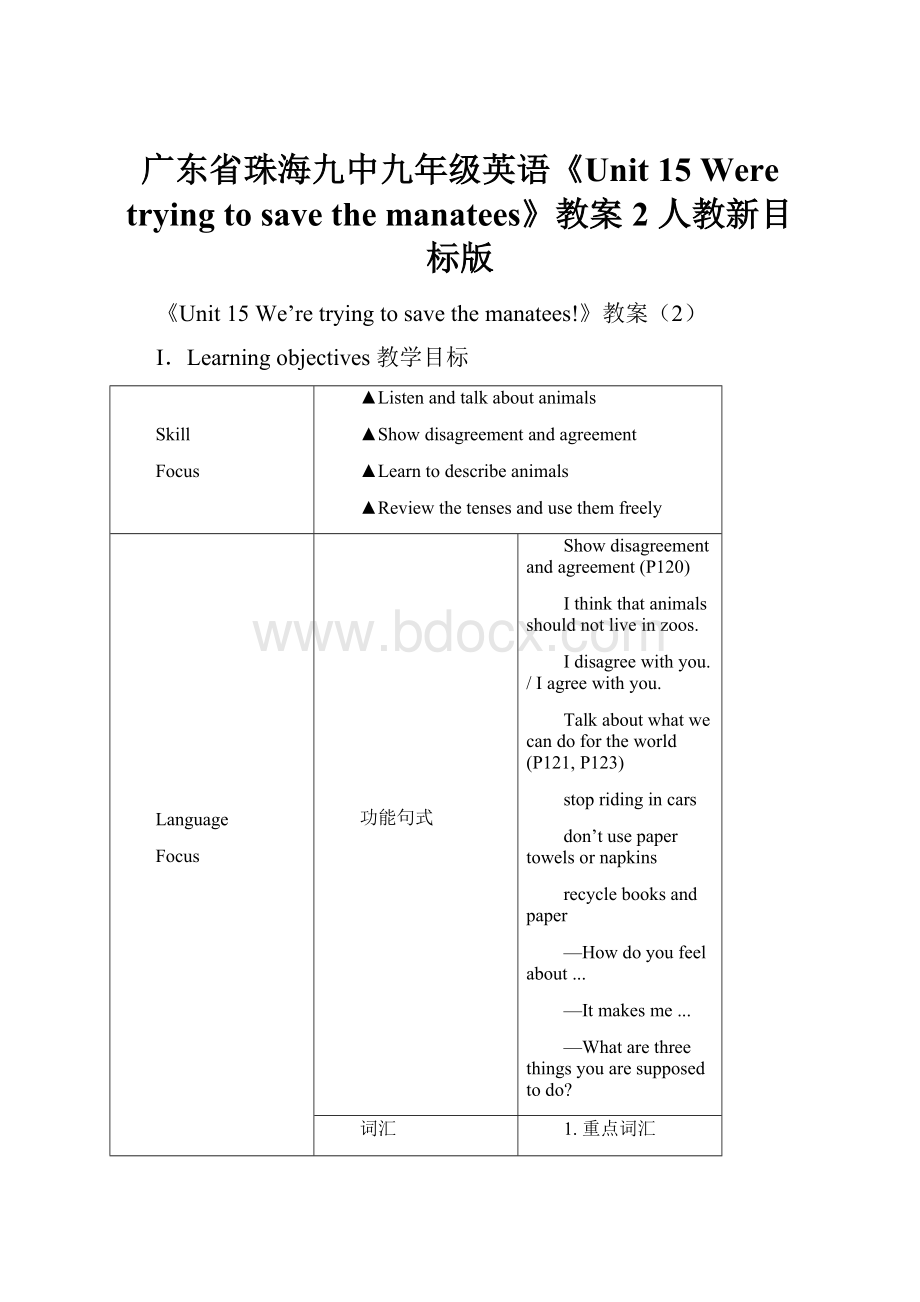广东省珠海九中九年级英语《Unit 15 Were trying to save the manatees》教案2 人教新目标版.docx
《广东省珠海九中九年级英语《Unit 15 Were trying to save the manatees》教案2 人教新目标版.docx》由会员分享,可在线阅读,更多相关《广东省珠海九中九年级英语《Unit 15 Were trying to save the manatees》教案2 人教新目标版.docx(27页珍藏版)》请在冰豆网上搜索。

广东省珠海九中九年级英语《Unit15Weretryingtosavethemanatees》教案2人教新目标版
《Unit15We’retryingtosavethemanatees!
》教案
(2)
I.Learningobjectives教学目标
Skill
Focus
▲Listenandtalkaboutanimals
▲Showdisagreementandagreement
▲Learntodescribeanimals
▲Reviewthetensesandusethemfreely
Language
Focus
功能句式
Showdisagreementandagreement(P120)
Ithinkthatanimalsshouldnotliveinzoos.
Idisagreewithyou./Iagreewithyou.
Talkaboutwhatwecandofortheworld(P121,P123)
stopridingincars
don’tusepapertowelsornapkins
recyclebooksandpaper
—Howdoyoufeelabout...
—Itmakesme...
—Whatarethreethingsyouaresupposedtodo?
词汇
1.重点词汇
pound,discover,expression,pull,planet,society,model,raise
2.认读词汇
manatee,furry,enormous,playful,aggressive,gray,spotted,kangaroo,chim-panzee,cheetah,mangrove,swamp,habitat,aquatic,u-nderwater,vegetation,weigh,polluted,presentprogressive,presentsimple,infinitive,pas-sivevoice,presentperfect,suitable,tiny,cage,disgusted,educate,urge,recycle,built,stuff,glue,roof,discard,tile,fence,can,recently,inspira-tion,spare,Winterbourne
3.词组
carefor
语法
Reviewthetenses:
PresentPro-gressive,PresentSimple,“usedto”,PassiveVoiceandPresentperfect
Strategy
Focus
1.Classifying
2.Listeningforspecificinformation
Culture
Focus
Theimportanceofprotectinganimalsandtheenvironment
II.Teachingmaterialsanalyzingandrearranging教材分析和重组
1.教材分析
本单元以Protectingtheenvironment为话题,共设计了三个部分的内容:
SectionA
该部分有4个模块:
第一模块围绕Describingtheanimals这一话题展开思维(1a)、听力(1b)、口语(1c)训练;第二模块围绕We’retryingtosavethemanatees进行听力(2a-2b)、口语(2c)训练;第三模块以Whethertobuildzoos就如何保护动物这一话题展开讨论,观点一:
反对建动物园(3a);观点二:
支持动物园建设(3b);第四模块仍就是否需要动物园这一话题,以小组活动形式展开讨论(4)。
SectionB
该部分有4个模块:
第一模块以Howtosavetheplanet展开话题,列举观点(1a),并展开讨论(1b);第二模块仍然以“保护环境”为话题,继续对Howtosavetheenvironment进行听力(2a-2b)、口语(2c)训练;第三模块围绕Howtorecycle这一话题展开阅读(3a)和写作(3b)训练;第四模块仍以Recycling为话题,以口语训练形式展开小组活动(4)。
Selfcheck
该部分有2个模块:
第一模块以填空形式对所学词汇进行训练
(1);第二模块要求利用所给句型展开自由对话,以训练学生对所学知识的实际运用能力
(2)。
2.教材重组和课时分配
Period1(SectionA:
1a,1b,1c,2a,2b,2c)
Newfunctionpresenting
Period2(SectionA:
3a,3b,4)
Practice
Period3(SectionB)
Integratingskills
Period4(Selfcheck:
1,2)
Comprehensivereview
III.Teachingplansforeachperiod
分课时教案
Period1Newfunctionpresenting
Languagegoals语言目标
1.Words&&expressions生词和短语
save,gentle,furry,enormous,playful,aggressive,gray,spotted,manatee,cheetah,chimpanzee,kangaroo,mangrove,swamp,habitat,aquatic,feed,underwater,vegetation
2.Keysentences重点句子(P119)
Wearetryingtosavethemanatees.
Manateeseatabout100poundsoffoodaday.
Thereusedtobealotofmanatees.
In1972,itwasdiscoveredthattheywereendangered.
Abilitygoals能力目标
Enablethestudentstodescribeanimals.
Emotion&&attitudegoals情感和态度目标
Enablethestudentstoprotectanimalsandenvironmentgladly.
Strategygoals策略目标
Tounderstandthetargetlanguagebyreadingpictures.
Cultureawarenessgoals文化意识目标
Theimportanceofprotectinganimalsandtheenvironment.
Teachingimportantpoints教学重点
Talkabouttheanimalsandwhethertobuildzoos.
Teachingproceduresandways教学过程与方式
StepIRevisionandLead-in
Askthestudentstoshowtheirwork.
T:
Inthelastunit,we’velearnedtotalkaboutthethingsthatwehavedone.NowI’llaskyouaquestion:
Haveyoueverbeentoazoo?
Whatkindofanimalscanyouseeinit?
S1:
Inthezooofourcitywecanseetigers,lions,elephants,andmonkeys.
S2:
Icanseedeerandsheep.
S3:
Wecanseesomechickens,birds,camelsandhorses....
T:
Haveyoueverseencheetahs,pandasormanateesinourzoos?
Ss:
No,wehaven’t.
T:
Doyouknowwhywecan’tseetheseanimalsinourzoos?
Ss:
Ithinktheyarerare./Therearen’tanyinourcountry...
T:
Someanimalscan’tbeseenbecausetheyareendangered.Soweshouldprotectthem.
Showthepictureofamanatee.
T:
Nowlookatthepicture.Thisanimaliscalledmanatee.It’sendangered,too.Wecan’tseeitinthezoo,either.OK!
Todaywe’lllearnUnit15.We’retryingtosavethemanatees!
Writedownthetopic:
We’retryingtosavemanatees!
Askthestudentstolookatthepictureandanswerthequestion.
T:
Weknowanimalsareourbestfriends.Nowlookatthepicture,pleasetellmewhichanimalyoulikebestandwhyyoulikeit.
Showthefollowingpicturetothestudents.
S1:
Ilikepandasbestbecausetheyaregentle.
Writetheword“gentle”ontheblackboardandaskformoreideasfromotherstudents.
S2:
Iliketigersbestbecausetheyarethekingsoftheanimals.
T:
Weknowtigersareveryaggressive.
Writetheword“aggressive”downontheblackboard.
S3:
Ilikemonkeysbestbecausetheyarecleverandtheycanclimbtreesveryquickly.Theyareplayful.
Writedownmoreusefulwordsontheblackboard.
StepIIBrainstorming(1a:
P118)
T:
Good.Whenwedescribeanimals,weoftenusesomeadjectives,suchasenormous,spotted,gray...Nowpleasefindoutthewordsthatcandescribetheanimals.Youcanusetheadjectivesfrom1a.
Kangaroos:
____________________________
Manatees:
____________________________
Cheetahs:
____________________________
Polarbears:
____________________________
Elephants:
____________________________
Chimpanzees:
____________________________
Sampleanswers:
Kangaroos:
playful,fast,big
Manatees:
gentle,shy,enormous
Cheetahs:
spotted,fast,aggressive
Polarbears:
aggressive,furry,fat
Elephants:
enormous,gray,strong
Chimpanzees:
noisy,furry,ugly
StepIIIListeningandOralPractice(1b,1c:
P118)
T:
NextyouwillhearGinnyandVictortalkingabouttheanimalsinthepicturein1a.Pleaselisten.Forthefirsttime,getthemainidea.Keepdownthewordsusedtodescribetheanimalswhilelistening.OK?
Playtherecording.Thenchecktheanswers.
T:
Wejustnowheardthatmanateesaregentleandveryshy.Ithinkdifferentpeoplearelikedifferentanimalstosomeextent.Differentanimalshavedifferentcharacters.Forexample,Jimislikeamonkeybecauseheiscleverandhecanclimbtreesveryquickly.Pleasetalkwithyourpartnersaboutwhatyouarelike.First,readtheexamplefrom1cintheboxplease.
Letthestudentsworkwiththeirpartners.
T:
Whichpairswouldliketoactoutyourdialogues?
Sampledialogue1:
S1:
IamlikethisanimalbecauseIamstrongandliveintheforest.
S2:
Youarelikealion.
S1:
No.
S2:
Youarelikeatiger.
S1:
No.BecauseIdon’teatmeat.
S2:
Youarelikeanelephant.
S1:
Yes.Youareright.
Sampledialogue2:
S1:
I’mlikethisanimalbecauseI’mspotted.IliketoeatmeatandIcanrunfast.
S2:
You’relikeatiger.
S1:
No.
S2:
Youarelikeacheetah.
S1:
Yes.
Sampledialogue3:
S1:
IamlikethisanimalbecauseIamgentleandveryshy.Iliveinwater.
S2:
You’relikeamanatee.
S1:
Yes!
Youaregreat!
StepIVListeningPractice(2a,2b:
P119)
T:
OK.Weallknowthatmanateesaregentleandveryshy.Theyliveinwaterandlikeeatingvegetables.Butdoyouwanttoknowmoreaboutthem?
Firstlet’slookatthepictureonpage119.Canyousaymoreaboutmanatees?
Sampleanswers:
S1:
Ithinktheyarelivinginthewater.
S2:
Ibelievethattheyeataquaticfood.
S3:
Ifeelthattherearen’tmanyofthem.
S4:
Iknowthattheyliveinaplacewheretreesgrowinwater.
S5:
Ithinktheyareendangered.
Askthestudentstolistentotherecording.
T:
Verywell.Ithinkyouranswersareallright.Manateesintheworldarefewerandfewer.Weshouldsavethem.Weshouldtakecareoftheenvironmentthattheyarelivingin.Nowlet’slistentothetape.Firstlistentotherecordingandmatchthewordsanddefinitionsin2a.
Playtherecordingforthefirsttime.
T:
Listenagainandcheckyouranswers.
Playtherecordingforthesecondtime.Checktheanswers.
T:
You’llhearthesameconversationagain.Thistimecompletethechartin2b.Putyouranswersontheline.
Playtherecordingagain,thenchecktheanswers.
StepVPairwork(2c:
P119)
T:
Afterlistening,weknowmoreaboutmanatees.Weknowthattheyarefewerandfewer.Thegovernmenthaspassedlawstoprotectthem.Theyeatalotoffoodeveryday.Theyareenormous.Canyoumakeconversationsabouttheanimalinpairs?
Youcanbaseonthemodeldialoguein2c.
Asampledialogue:
S1:
HowmanymanateesarethereintheUS?
S2:
About2,500.
S1:
Wherearetheyliving?
S2:
Theirfavoritehabitatisinthewaterunderthetreesinmangroveswamps.
S1:
Whyaretheyendangered?
S2:
Someoftheswampshavebeenpolluted.
S1:
Dotheyeatalot?
S2:
Yes,theydo.
...
StepVIGrammar(GrammarFocus:
P119)
Helpthestudentssumupthefollowingpatterns.
时态
谓语动词的形式(do)
一般现在时
do/does
一般过去时
did
现在进行时
be(am/is/are)doing
现在完成时
have/hasdone
一般过去时被动语态
was/weredone
现在完成时被动语态
have/hasbeendone
T:
LookattheGrammarFocusboxonpage119.Nowwho’dliketoreadthesentencestotheclass?
Askastudenttoreadthesentencesinthebox.
T:
Canyoumakesomesentenceswiththedifferenttensesandpassivevoice?
Pleasewritedownyoursentencesinyourexercise-books.
Askthestudentstodomorepracticingexercises,suchasthefollowing:
Fillintheblankswiththerightformsofthegivenwords.
1.Everydaymymother_____(get)upearly.
2.Thedinosaureggs_____(discover)manyyearsagobyscientists.
3.Listen!
Somechildren_____(sing)anEnglishsongoverthere.
4.Inourhometownthereusedto_____(be)manyoldtrees.
5.Mywork_____(notfinish)yet.Ican’tgoouttoplaywithyou.
Sampleanswers:
1.gets2.werediscovered3.aresinging
4.be5.hasn’tbeenfinished
StepVIIHomework
T:
Inthisclass,we’veheardtwospokenconvers